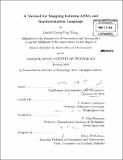| dc.contributor.advisor | I. Kristina Lundqvist and R. John Hansman. | en_US |
| dc.contributor.author | Wang, David Cheng-Ping | en_US |
| dc.contributor.other | Massachusetts Institute of Technology. Dept. of Aeronautics and Astronautics. | en_US |
| dc.date.accessioned | 2010-09-01T13:41:06Z | |
| dc.date.available | 2010-09-01T13:41:06Z | |
| dc.date.copyright | 2010 | en_US |
| dc.date.issued | 2010 | en_US |
| dc.identifier.uri | http://hdl.handle.net/1721.1/57985 | |
| dc.description | Thesis (S.M.)--Massachusetts Institute of Technology, Dept. of Aeronautics and Astronautics, 2010. | en_US |
| dc.description | Cataloged from PDF version of thesis. | en_US |
| dc.description | Includes bibliographical references (p. 193-196). | en_US |
| dc.description.abstract | One of the challenges of model-based engineering is traceability: the ability to relate the set of models developed during the design stages to the implemented system. This thesis develops a language specific method for creating bidirectional traceability, a mapping between model and implementation, suitable for tracing requirements from model through implementation and vice versa. The mapping is created as a byproduct of code generation and reverse engineering, and can be used to subsequently synchronize changes between the model and implementation. The creation of the mapping is specifically demonstrated through generating Java code from an abstract state machine (ASM) based modeling language, called the Timed Abstract State Machine (TASM) language. This code generation process involves a series of three transformations. The first transformation creates a specialised System Dependency Graph (SDG) called a TASM SDG from a TASM specification. | en_US |
| dc.description.abstract | (cont.) The second uses Triple Graph Grammars to transform the TASM SDG to a Java SDG (JSDG). The applied grammars are saved as the mapping information. The third transformation procedurally generates Java code. In order to make this methodology possible, this thesis introduces the TASM SDG, as well as a novel algorithm, generally applicable to ASM languages, that explicates state transitions. The approach presented extends the bidirectional traceability capabilities inherent in the TASM language to Java. The code generation technique is demonstrated using an industrial case study from the automotive domain, an Electronic Throttle Controller (ETC). | en_US |
| dc.description.statementofresponsibility | by David Cheng-Ping Wang. | en_US |
| dc.format.extent | 196 p. | en_US |
| dc.language.iso | eng | en_US |
| dc.publisher | Massachusetts Institute of Technology | en_US |
| dc.rights | M.I.T. theses are protected by
copyright. They may be viewed from this source for any purpose, but
reproduction or distribution in any format is prohibited without written
permission. See provided URL for inquiries about permission. | en_US |
| dc.rights.uri | http://dspace.mit.edu/handle/1721.1/7582 | en_US |
| dc.subject | Aeronautics and Astronautics. | en_US |
| dc.title | A method for mapping between ASMs and implementation language | en_US |
| dc.type | Thesis | en_US |
| dc.description.degree | S.M. | en_US |
| dc.contributor.department | Massachusetts Institute of Technology. Department of Aeronautics and Astronautics | |
| dc.identifier.oclc | 639288594 | en_US |
